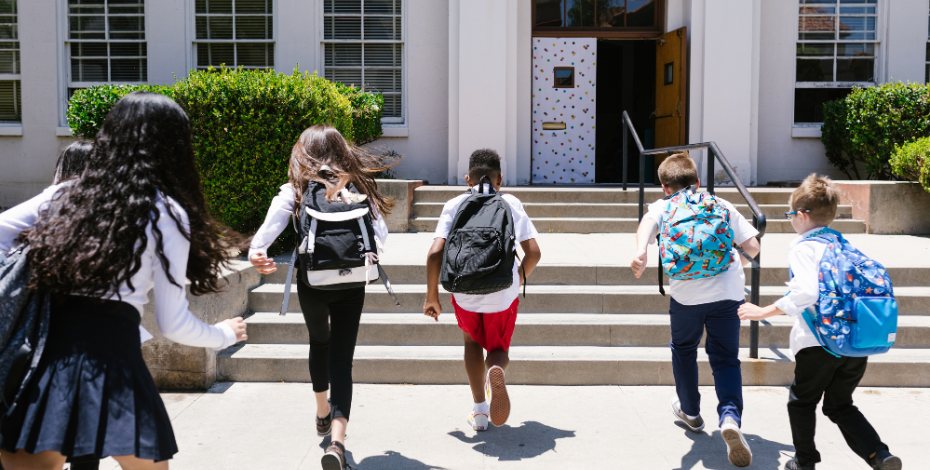
Recent studies1-5 have shown there is no clear association between heavy school back packs and low back pain in school children, contrary to the popular belief that the weight of a school bag is the main culprit behind the growing prevalence of low back pain in kids.
Low back pain (LBP) affects up to 4 in 10 Australian students at any point in time; 30 to 50 per cent will have pain persisting longer than three months3.
The Australian Physiotherapy Association (APA) is cautioning parents to not immediately assume back packs are the main contributor of back pain in kids, but to instead seek advice from a physiotherapist before returning to school if a child complains of back pain.
While school back packs may have some influence on pain, there are other factors to consider, explains APA Paediatric Physiotherapist Nicole Pates, national chair of the APA’s Paediatric group.
“The time spent carrying the bag over a long commute, or the child’s perceived weight of a school bag, may be linked to pain. Other factors relevant for teenagers include mental health challenges, a high physical load and excessive activity, a sedentary lifestyle, and factors relating to gender predisposing females to experience pain because of puberty or skeletal changes,” said Ms Pates.
“Low back pain is far more prevalent in kids than commonly thought, and as previous reports show back pain costs the Australian economy $4.8 billion each year6, it’s crucial parents put in the time to do preventative work with their kids to reduce this burden as they age,” Ms Pates said.
In terms of prevention, while parents do not need to weigh their child’s bag every day, it’s important to at least ask how the child feels about the weight of the back pack. If they perceive the back pack as heavy, it may be time for a physiotherapist to assess their physical capacity. If their physical capacity needs to be strengthened to more appropriately handle the load of the back pack, a physiotherapist will work with the child and their parents to increase their activity levels7.
Other than periods of muscle soreness following challenging physical activity, like after swimming lessons or playing sport, there are occasions where pain experienced may be abnormal and require investigation by a physiotherapist, said APA Pain and Musculoskeletal Physiotherapist Adnan Asger Ali, national chair of the APA’s Musculoskeletal group.
“Parents should bring their child in for an assessment especially if they are waking up with back pain during the night, experiencing weight loss or fever with back pain, suffering from stiffness in the morning, having back pain that limits function during daily activities, or back pain that doesn’t resolve over time,” said Mr Asger Ali.
“Physiotherapists have lots of tools at their disposal to assist, including exercise, manual therapy, education and therapeutic conditioning, and the recent Australian Commission on Safety and Quality in Health Care Low Back Pain Clinical Care Standard provides the most up-to-date evidence on low back pain management, which physiotherapists can implement,” said Mr Asger Ali.
Parents are encouraged to visit a paediatric or musculoskeletal physiotherapist before school returns if their child complains of low back pain. Physiotherapy services can be found here.
-ENDS-
References:
1 Calvo‐Muñoz, I., Kovacs, F. M., Roqué, M., & Seco‐Calvo, J. (2020). The association between the weight of schoolbags and low back pain among schoolchildren: A systematic review, meta‐analysis and individual patient data meta‐analysis. European Journal of Pain, 24(1), 91-109.
2 Frosch, M., Mauritz, M. D., Bielack, S., Blödt, S., Dirksen, U., Dobe, M., … & Zernikow, B. (2022). Etiology, risk factors, and diagnosis of back pain in children and adolescents: evidence-and consensus-based interdisciplinary recommendations. Children, 9(2), 192.
3 Kamper, S. J., Yamato, T. P., & Williams, C. M. (2016). The prevalence, risk factors, prognosis and treatment for back pain in children and adolescents: an overview of systematic reviews. Best Practice & Research Clinical Rheumatology, 30(6), 1021-1036.
4 Oka, G. A., Ranade, A. S., & Kulkarni, A. A. (2019). Back pain and school bag weight–a study on Indian children and review of literature. Journal of Pediatric Orthopaedics B, 28(4), 397-404.
5 Yamato, T. P., Maher, C. G., Traeger, A. C., Wiliams, C. M., & Kamper, S. J. (2018). Do schoolbags cause back pain in children and adolescents? A systematic review. British Journal of Sports Medicine, 52(19), 1241-1245.
6 Australian Commission on Safety and Quality in Health Care (2022). A novel approach to break the cycle of low back pain. Available at https://www.safetyandquality.gov.au/about-us/latest-news/media-releases/novel-approach-break-cycle-low-back-pain
7 Western Kids Health (2023). Do school bags cause back pain? Available at https://westernkidshealth.com/school-aged-services/do-school-bags-cause-back-pain
For further information, please contact:
Manager, Media and PR
Tel: 03 9092 0838
Email: media@australian.physio
Related tags
